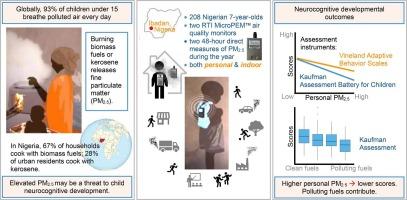细颗粒物空气污染(PM2·5)对尼日利亚儿童7岁时认知和神经行为发展测试成绩的影响
IF 9.7
1区 环境科学与生态学
Q1 ENVIRONMENTAL SCIENCES
引用次数: 0
摘要
细颗粒物(PM2·5)空气污染暴露过高威胁儿童健康和发育。在撒哈拉以南非洲,煤油和生物质烹饪燃料是PM2·5的一个来源。对儿童认知和神经行为发展的潜在影响有待调查。在2021年9月至2023年3月的一项横断面观察研究中,我们使用基于表现的KABC-II(神经认知)和两份家长问卷:VABS-3(适应行为)和SDQ(心理适应),评估了208名尼日利亚7岁儿童的认知和神经行为发展。我们收集了社会人口学协变量的数据。我们使用两个RTI MicroPEM™传感器进行了两次48小时PM2·5(µg/m3)暴露监测:室内(家庭)和个人(身体穿戴)。我们使用多元线性回归检验了平均pm2.5暴露与儿童发育评估得分之间的关系,并对儿童的年龄和性别、母亲/照顾者的年龄和教育程度以及家庭财富进行了调整。结果发现,在调整协变量后,个人平均pm2.5暴露增加两倍,与3.04个单位降低(95 % CI: - 4.62, - 1.46; p <; 0.001)kbc - ii评分和2.18个单位降低(95 % CI: - 4.79, 0.43; p = 0.10)VABS-3评分相关。使用清洁燃料家庭的儿童在两项评估中得分都较高,尽管调整后差异并不显著。调整后,只使用污染性燃料的家庭的kbc - ii得分较低(- 4.07,95 % CI: - 8.12, - 0.02; p = 0.049)。我们发现PM2·5水平或燃料类型与SDQ评分之间没有关联。在尼日利亚7岁儿童中,童年中期个人pm2.5暴露水平升高与较低的发育评估分数有关。家庭使用污染性烹饪燃料是造成这些暴露的原因之一。本文章由计算机程序翻译,如有差异,请以英文原文为准。

Impact of fine particulate matter air pollution (PM2·5) on Nigerian children’s performance on tests of cognitive and neurobehavioral development at age seven years
Background
Elevated exposures to fine particulate matter (PM2·5) air pollution threaten child health and development. Kerosene and biomass cooking fuels are a source of PM2·5 in sub-Saharan Africa. Potential impacts on child cognitive and neurobehavioral development require investigation.Methods
In a cross-sectional observational study, September 2021 − March 2023, we assessed cognitive and neurobehavioral development in 208 Nigerian seven-year-old children using the performance-based KABC-II (neurocognition) and two parent questionnaires: VABS-3 (adaptive behavior) and SDQ (psychological adjustment). We collected data on sociodemographic covariates. We conducted 48-hour PM2·5 (µg/m3) exposure monitoring twice using two RTI MicroPEM™ sensors: indoor (in-home) and personal (body-worn). We examined the relationship between mean PM2·5 exposures and child developmental assessment scores using multiple linear regression, adjusting for child’s age and sex, mother/caregiver’s age and education, and household wealth.Findings
A two-fold increase in mean personal PM2·5 exposures was associated with 3·04-unit lower (95 % CI: −4·62, −1·46; p < 0·001) KABC-II scores and 2·18-unit lower (95 % CI: −4·79, 0·43; p = 0·10) VABS-3 scores, after adjustment for covariates. Children in households using clean fuels scored higher on both assessments, although the differences were not significant after adjustment. Those in households using exclusively polluting fuel had lower KABC-II scores after adjustment (−4·07, 95 % CI: −8·12, −0·02; p = 0·049). We found no associations between PM2·5 levels or fuel types and SDQ scores.Interpretation
Elevated personal PM2·5 exposures during middle childhood are associated with lower developmental assessment scores in Nigerian seven-year-old children. Household use of polluting cooking fuels contributes to these exposures.求助全文
通过发布文献求助,成功后即可免费获取论文全文。
去求助
来源期刊

Environment International
环境科学-环境科学
CiteScore
21.90
自引率
3.40%
发文量
734
审稿时长
2.8 months
期刊介绍:
Environmental Health publishes manuscripts focusing on critical aspects of environmental and occupational medicine, including studies in toxicology and epidemiology, to illuminate the human health implications of exposure to environmental hazards. The journal adopts an open-access model and practices open peer review.
It caters to scientists and practitioners across all environmental science domains, directly or indirectly impacting human health and well-being. With a commitment to enhancing the prevention of environmentally-related health risks, Environmental Health serves as a public health journal for the community and scientists engaged in matters of public health significance concerning the environment.
 求助内容:
求助内容: 应助结果提醒方式:
应助结果提醒方式:


